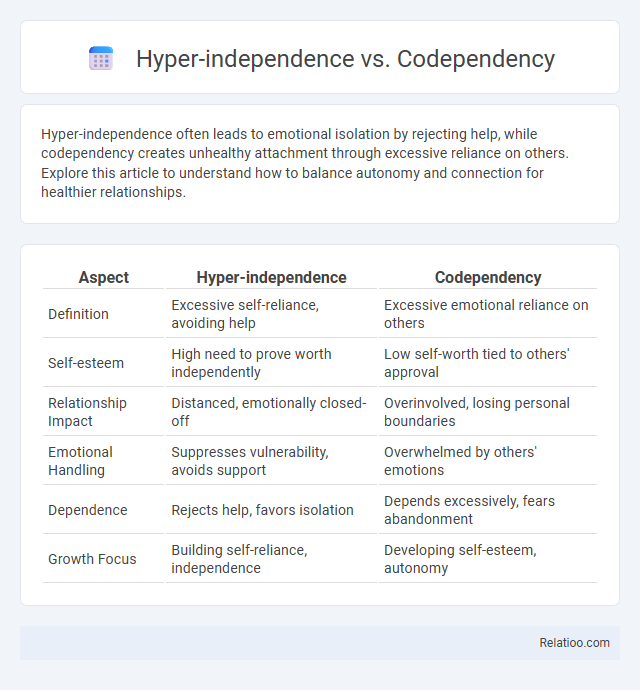Hyper-independence often leads to emotional isolation by rejecting help, while codependency creates unhealthy attachment through excessive reliance on others. Explore this article to understand how to balance autonomy and connection for healthier relationships.
Table of Comparison
| Aspect | Hyper-independence | Codependency |
|---|---|---|
| Definition | Excessive self-reliance, avoiding help | Excessive emotional reliance on others |
| Self-esteem | High need to prove worth independently | Low self-worth tied to others' approval |
| Relationship Impact | Distanced, emotionally closed-off | Overinvolved, losing personal boundaries |
| Emotional Handling | Suppresses vulnerability, avoids support | Overwhelmed by others' emotions |
| Dependence | Rejects help, favors isolation | Depends excessively, fears abandonment |
| Growth Focus | Building self-reliance, independence | Developing self-esteem, autonomy |
Understanding Hyper-Independence
Hyper-independence is characterized by an excessive reliance on oneself, often leading to an unwillingness to seek help or collaborate with others, which can hinder emotional growth and relationship development. Unlike codependency, where individuals depend excessively on others for validation and support, hyper-independent individuals prioritize autonomy to the point of isolation and emotional suppression. Understanding hyper-independence requires recognizing its roots in fear of vulnerability or past trauma, which drive a person's intense need for self-sufficiency despite potential negative social and psychological impacts.
Defining Codependency
Codependency is characterized by an excessive emotional or psychological reliance on a partner, often leading to a diminished sense of self and difficulty setting healthy boundaries. Unlike hyper-independence, where individuals prioritize self-reliance and autonomy, codependent individuals seek validation through caretaking and approval from others. Understanding codependency involves recognizing patterns of enabling behaviors, low self-esteem, and a compromised ability to meet one's own needs independently.
Key Differences Between Hyper-Independence and Codependency
Hyper-independence involves relying solely on Yourself and avoiding support, while codependency centers on excessive reliance on others for approval and validation. Hyper-independence prioritizes autonomy, often leading to isolation, whereas codependency fosters unhealthy attachments and loss of personal boundaries. Understanding these key differences helps identify patterns that impact emotional well-being and relationship dynamics.
Psychological Roots of Hyper-Independence
Hyper-independence often stems from past emotional neglect or trauma, where individuals develop a strong need to rely solely on themselves to avoid vulnerability and rejection. Unlike codependency, characterized by excessive reliance on others for validation and support, hyper-independence pushes people to suppress their need for help, leading to isolation and inhibited emotional expression. Understanding your hyper-independence requires acknowledging these psychological roots to foster healthier interdependence and emotional balance.
Causes and Origins of Codependency
Codependency often originates from dysfunctional family dynamics, such as neglect, abuse, or emotional unavailability, leading individuals to prioritize others' needs over their own to gain validation. In contrast, hyper-independence arises from childhood experiences of neglect or inconsistent caregiving, fostering a strong self-reliance to avoid vulnerability and dependence on others. Understanding these root causes highlights the importance of addressing early emotional wounds to promote healthier relational patterns.
Signs and Symptoms of Hyper-Independence
Hyper-independence is characterized by an excessive reliance on oneself, often manifesting as a strong need to control every aspect of life and reluctance to seek help, distinguishing it from codependency, which involves excessive reliance on others. Signs and symptoms of hyper-independence include chronic self-sufficiency, difficulty trusting others, emotional isolation, and resistance to vulnerability. Understanding your own hyper-independent tendencies can help you balance self-reliance with healthy interpersonal connections.
Signs and Symptoms of Codependency
Codependency is characterized by excessive emotional reliance on others, often manifesting as low self-esteem, people-pleasing behavior, and difficulty setting boundaries. Symptoms include sacrificing personal needs to support others, a strong fear of abandonment, and feeling responsible for other people's feelings and actions. Unlike hyper-independence, which involves extreme self-reliance and emotional detachment, codependency revolves around dysfunctionally enmeshed relationships and a lack of autonomy.
Impact on Relationships and Personal Well-being
Hyper-independence often leads to emotional isolation and difficulty relying on others, straining relationships and increasing stress, while codependency fosters unhealthy attachment and loss of personal boundaries, causing emotional exhaustion and reduced self-esteem. Your ability to balance autonomy with mutual support is crucial for maintaining healthy connections and personal well-being. Recognizing the signs of hyper-independence and codependency allows you to cultivate emotional resilience and create more satisfying, balanced relationships.
Healing Strategies for Hyper-Independent and Codependent Patterns
Healing strategies for hyper-independent patterns emphasize setting healthy boundaries, practicing vulnerability, and seeking supportive relationships to reduce isolation and emotional suppression. For codependent patterns, effective approaches include developing self-awareness, fostering autonomy, and engaging in therapy or support groups to break enabling behaviors and build self-esteem. Both require cultivating balance between self-reliance and connection to promote emotional resilience and healthy interdependence.
Achieving Healthy Interdependence
Achieving healthy interdependence involves balancing autonomy and connection, moving beyond the extremes of hyper-independence and codependency. Hyper-independence often leads to emotional isolation due to reluctance to seek support, while codependency causes excessive reliance on others for validation and self-worth. Cultivating mutual respect, open communication, and emotional support fosters a dynamic relationship where individuals maintain personal boundaries while collaborating effectively.

Infographic: Hyper-independence vs Codependency
 relatioo.com
relatioo.com